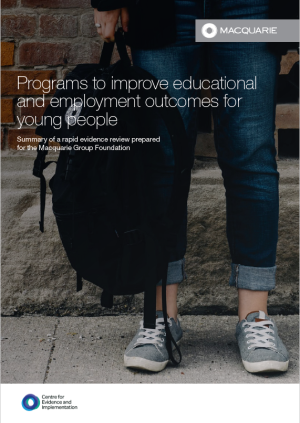More than one in 10 young people in the UK are not in education, employment or training (NEET) – that is 770,000 young people (389,000 men and 381,000 women), according to the latest figures. Young people from marginalised backgrounds are more likely to fall into this category.
Barely shifting in more than a decade, the NEET rate of young people is a statistic that points to significant lifelong disadvantage.
To tackle this pervasive issue with evidence-based action, Youth Futures Foundation commissioned a team of researchers from CEI, the Institute for Employment Studies and Monash University to undertake an evidence synthesis. Aimed at policymakers, employers and practitioners, the Foundation has dubbed it “the world’s first Youth Employment Toolkit.”
“The Toolkit is a free, online resource of evidence-based guidance on policy and practice that can improve youth employment outcomes,” says CEI Senior Advisor Dr Ellie Ott. “It is based on a robust synthesis of evidence for seven different types of youth employment interventions, with more to be added over time.”
CEI Advisor Jamie Rowland adds: “For example, off-the-job vocational training is likely to have a good impact for young people facing employment disadvantage. It is likely to have greater impact for young people facing additional barriers to finding and keeping a job, such as those living with a disability, who have been involved with the criminal justice system, or care-experienced young people.”
Building the Toolkit
The research team reviewed more than 700 published articles and reports, with over 70 meeting criteria for quality and relevance.
“Research can be hard to navigate. That’s why the Youth Employment Toolkit brings together high-quality evidence in an accessible format, including assessment of the strengths and limitations of available findings,” Jamie explains. “There are also summaries of rigorous literature reviews that draw together evidence from multiple evaluations of youth employment initiatives in high-income countries across the globe.”
“Published studies of interventions that may help young people into employment proved highly variable in focus and quality, with few using the ‘gold-standard’ of randomised or comparison group design. There are also few systematic reviews of evaluations, which provide a higher standard of evidence.”
And gaps have been identified. “Some potentially effective interventions have not been evaluated well enough or at all,” Ellie notes. “And where evaluations have been done, these don’t always provide information about everything Toolkit users would like to know.”
Using a Network Meta-Analysis (NMA)
Most youth employment programs consist of more than one kind of intervention, which presents challenges for evaluators trying to work out which have contributed to observed impacts. To deal with this problem, the Toolkit team took the innovative path of a Network Meta-Analysis (NMA) – to their knowledge, the first toolkit based on this type of analysis.
“This method allowed us to synthesise quantitative data from evaluations, so we could compare multiple types of intervention and tease out the impacts of specific intervention components, such as apprenticeship, off-the job training, life skills or basic skills,” says Ellie.
“Basing what we do on what we know works, and continuing to build the evidence, is key to solving intractable disadvantage – in employment and in other fields.”
“Although we need further research in some areas, there is good evidence for what works in youth employment. We hope the Toolkit means it can be more widely used.”
Access the Youth Employment Tookit
CEI’s core team of Dr Ellie Ott, Jamie Rowland, Sarah Mackenzie and Caitlin Clymer worked with David Taylor, Rebecca Featherston and Professor Aron Shlonsky from Monash University, and Becci Newton and Dr Alexandra Nancarrow from the Institute for Employment Studies, to develop the Youth Employment Toolkit. The project was funded by Youth Futures Foundation.


